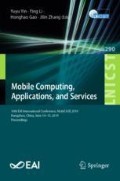Abstract
Classification and treatment of vehicle defect complaint data is an important link in the process of vehicle recall. Traditionally, the complaint data is classified by keyword matching method based on defect label library during the process of dealing with vehicle complaint data, which heavily relies heavily on the quality of the vehicle defect label library. The speed of traditional classification methods is rapid, but the accuracy is low. We transform the classification task of vehicle complaint data into a multi-label classification problem. Multi-label classification of vehicle defect information collection based on seq2seq model named VDIF-M is proposed in this paper. Firstly, a synonymous vehicle defect description label library is constructed based on the vehicle defect description data and vehicle domain corpus collected from various channels. Then a seq2seq model is proposed to solve the problem of multi-label classification of vehicle complaint data, which fuses the distribution relationship between labels. Substantial experimental results show that the proposed method outperforms previous methods in multi-label classification of vehicle complaint data.
Access this chapter
Tax calculation will be finalised at checkout
Purchases are for personal use only
References
Defective Product Administrative Center Homepage. http://www.dpac.gov.cn. Accessed 24 Jan 2019
Boutell, M.R., Luo, J., Shen, X.: Learning multi-label scene classification. Pattern Recogn. 37(9), 1757–1771 (2004)
Zhang, M.L., Wu, L.: Lift: multi-label learning with label-specific features. In: International Joint Conference on Artificial Intelligence, pp. 1609–1614. AAAI Press (2017)
Tsoumakas, G., Katakis, I.: Multi-label classification: an overview. Int. J. Data Warehous. Min. 3(3), 1–13 (2006)
Read, J., Pfahringer, B., Holmes, G.: Classifier chains for multi-label classification. Mach. Learn. 85(3), 333 (2011)
Clare, A., King, R.D.: Knowledge discovery in multi-label phenotype data. In: De Raedt, L., Siebes, A. (eds.) PKDD 2001. LNCS (LNAI), vol. 2168, pp. 42–53. Springer, Heidelberg (2001). https://doi.org/10.1007/3-540-44794-6_4
Elisseeff, A., Weston, J.: A kernel method for multi-labelled classification (2002)
Zhang, M.L., Zhou, Z.H.: ML-KNN: a lazy learning approach to multi-label learning. Pattern Recogn. 40(7), 2038–2048 (2007)
Li, L., Wang, H., Sun, X., et al.: Multi-label text categorization with joint learning predictions-as-features method. In: Conference on Empirical Methods in Natural Language Processing, pp. 835–839 (2015)
Zhang, M.L., Zhou, Z.H.: Multi-label neural networks with applications to functional genomics and text categorization. IEEE Trans. Knowl. Data Eng. 18(10), 1338–1351 (2006)
Chen, G., Ye, D., Xing, Z., et al.: Ensemble application of convolutional and recurrent neural networks for multi-label text categorization. In: International Joint Conference on Neural Networks, pp. 2377–2383. IEEE (2017)
Baker, S., Korhonen, A.: Initializing neural networks for hierarchical multi-label text classification. In: BioNLP, pp. 307–315 (2017)
Yang, P., Sun, X., Li, W., et al.: SGM: sequence generation model for multi-label classification (2018)
Chinese synonyms Toolkit. https://github.com/huyingxi/Synonyms. Accessed 24 Jan 2019
Chinese Word Segmentation Tool. https://pypi.org/project/jieba/. Accessed 24 Jan 2019
Zhang, Y., Li, B., Lv, X.: Research on domain term dictionary construction based on Chinese Wikipedia. Image Processing, Computing and Big Data (2018)
Mikolov, T., Chen, K., Corrado, G., et al.: Efficient estimation of word representations in vectorspace. arXiv preprint arXiv:1301.3781 (2013)
Graves, A.: 2005 Special Issue: Framewise phoneme classification with bidirectional LSTM and other neural network architectures. Elsevier Science Ltd. (2005)
Schapire, R.E., Singer, Y.: Improved boosting algorithms using confidence-rated predictions. Mach. Learn. 37(3), 297–336 (1999)
Manning, C.D., Raghavan, P., Schütze, H., et al.: Introduction to Information Retrieval, vol. 1. Cambridge University Press, Cambridge (2008)
Wiseman, S., Rush, A.M.: Sequence-to-sequence learning as beam search optimization. CoRR, abs/1606.02960 (2016)
Szymański, P.: A scikit-based python environment for performing multi-label classification. arXiv preprint arXiv:1702.01460 (2017)
Acknowledgments
This work is supported by National Natural Science Foundation of China under Grants No. 61671070, National Science Key Lab Fund project 6142006190301, National Language Committee of China under Grants ZDI135-53, and Project of Three Dimension Energy Consumption Saving Strategies in Cloud Storage System in Promoting the Developing University Intension–Disciplinary Cluster No. 5211910940.
Author information
Authors and Affiliations
Corresponding author
Editor information
Editors and Affiliations
Rights and permissions
Copyright information
© 2019 ICST Institute for Computer Sciences, Social Informatics and Telecommunications Engineering
About this paper
Cite this paper
You, X., Zhang, Y., Li, B., Lv, X., Han, J. (2019). VDIF-M: Multi-label Classification of Vehicle Defect Information Collection Based on Seq2seq Model. In: Yin, Y., Li, Y., Gao, H., Zhang, J. (eds) Mobile Computing, Applications, and Services. MobiCASE 2019. Lecture Notes of the Institute for Computer Sciences, Social Informatics and Telecommunications Engineering, vol 290. Springer, Cham. https://doi.org/10.1007/978-3-030-28468-8_8
Download citation
DOI: https://doi.org/10.1007/978-3-030-28468-8_8
Published:
Publisher Name: Springer, Cham
Print ISBN: 978-3-030-28467-1
Online ISBN: 978-3-030-28468-8
eBook Packages: Computer ScienceComputer Science (R0)

